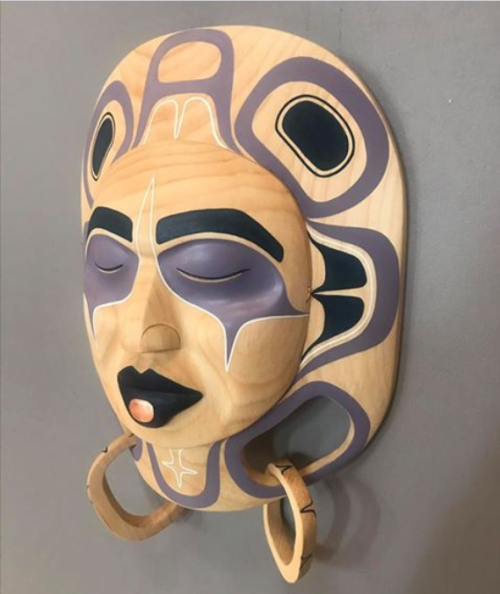When I attended the Freda Diesing School’s year end exhibit last April, I was the first in the doors when the campus longhouse was opened. As I stepped in, a mask caught my attention from across the room. The closer I came, the more I admired it. Eventually, I checked the artist, who turned out to be Jamie Katerina Nole, whose “Pregnant Frogwoman” print I bought several years ago. I hovered waiting for Nole, and, as soon as she arrived, I bought it – and who can blame me? “Princess Luna” is a piece of carving that starts with solid foundations, and consistently makes an extra effort that produces an outstanding work.

“Princess Luna.”
Of course I could not have foreseen that, through a series of misadventures that were no one’s fault, I would take four months to receive the mask. However, the delay only makes me appreciate the mask all the more.
As the name suggests, “Princess Luna” is a moon mask. Moon masks are common at the school, because the moon is not a family crest, but often they are learning exercises at best. The basic design consists of a face surrounded by a ring of U-shapes or ovoids and “Princess Luna” obviously begins with that design, although it soon heads off in its own direction.
To start with, the mask is made of alder, a pale wood that through a combination of selection and sanding seems suitable for the moon. Both the painting and the copper labret are restrained, and the face itself is more realistic than that of most moon masks, with closed eyes that create a sense of serenity and mystery that is reminiscent of standing in the light of the full moon. Like the “Pregnant Frogwoman,” print, the result is a sense of emotion that is rare in northwest coast art.
Similarly, the decorations around the rim can be viewed as covering the phrases of the moon, with the blank ovoid at the top the new moon, and the full moon at ear level on both sides of the mask.
Just these basics would be enough to make the mask more than a classroom exercise, but they are just the beginning. At the bottom, the stars are indicated, with cutouts and two loose rings cut from the same piece of wood as the rest of the mask – an impressive and seldom-seen display of skill. Turn the mask over, and the phases of the moon are shown again, although few people are likely to see it.

The back of the mask, showing the phases of the moon. Notice, too, the smooth finish on the back.
Yet the greatest extra effort is the use of luminous paint. If, like me, your eyes see some distance into the ultra-violet, this luminous paint adds to the sense of wonder in the mask by creating a sense of something that cannot quite be seen. In the twilight, the pale wood turns almost golden, and, under black light, creates an entirely different look to the mask, transforming it into a figure of power more awake that the mask appears under ordinary light.

“Princess Luna” by black light.
Nole is still experimenting with different styles. The Northern Exposure show included another two more of her experiments, “Trickster Flow,” which places a Modernist design across a conventional portrait mask, and “Raven – Don’t Froget Me Crest,” a frontlet painted in a non-traditional style. Neither is as successful as “Princess Luna,” but, like it, they create the impression of an innovative artist who is prepared to make the extra effort to produce original work. Nole has clearly made intelligent use of her time at the Freda Diesing school, and “Princess Luna” is proof that “The Pregnant Frogwoman” was a start and not just an accidental success. I can’t wait to see what she carves next — or what she will be carving in another twenty years.







